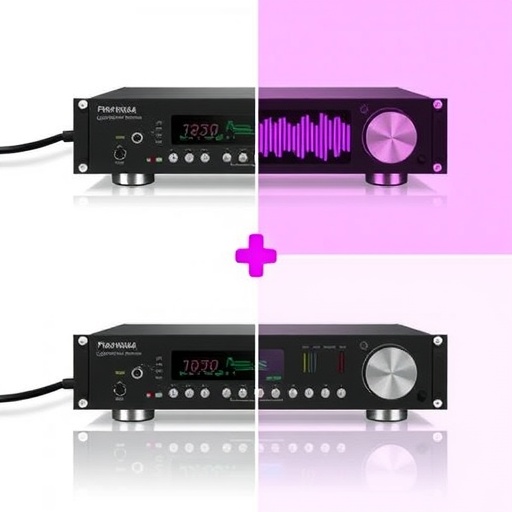In a groundbreaking advance poised to reshape the future of photonic computing and high-speed data transmission, researchers at Harvard’s John A. Paulson School of Engineering and Applied Sciences (SEAS) have developed an integrated electro-optic digital-to-analog link (EO-DiAL). This novel device seamlessly converts digital electronic signals directly into analog optical signals, eliminating the cumbersome and energy-intensive multi-step methods traditionally required in optical communication systems. Built upon the mature platform of thin-film lithium niobate photonics, the EO-DiAL promises a paradigm shift in the interplay between electronic and photonic technologies, heralding faster, more efficient data processing architectures.
The current landscape of photonic computing and data transmission is fundamentally constrained by the digital-to-analog conversion bottleneck. Traditional approaches rely on discrete electronic digital-to-analog converters (DACs) followed by electro-optic modulators to translate digital electrical inputs into analog optical waveforms capable of carrying information through fiber-optic networks. While effective, this two-stage procedure introduces significant inefficiencies, primarily in terms of energy consumption and system complexity. These inefficiencies become particularly pronounced in applications demanding ultra-high bandwidths and low latency, such as next-generation data centers and artificial intelligence platforms.
At the heart of this advancement lies a novel interferometric architecture that finely controls the phase and amplitude of light within nanoscale lithium niobate waveguides. This architecture enables arbitrary waveform generation (AWG) capabilities, allowing the direct synthesis of complex optical signals from simple digital inputs. This integrated modulatory process not only streamlines the conversion workflow but also dramatically reduces the power requirements typically associated with electronic DACs and modulators. Consequently, energy efficiency is enhanced, a salient factor for scalable deployments in photonic computing and communications.
Importantly, the EO-DiAL device was fabricated using a lithium niobate photonic foundry process developed by the Harvard spin-off HyperLight Corporation. This manufacturing approach is directly analogous to mature silicon photonics foundry procedures, demonstrating the scalability and manufacturability of the technology. By leveraging existing foundry infrastructure, the device can be produced at high volumes and relatively low costs, facilitating its integration into commercial photonic systems and accelerating adoption within the industry.
In practical demonstrations, the team showcased the potential of the EO-DiAL by optically encoding images from the well-known MNIST dataset, a standard benchmark in photonic computing research. This experiment underscored the precision and versatility of the device in handling complex data streams, highlighting its suitability for a wide range of data-driven applications, from telecommunications to machine learning hardware.
The implications of this development extend beyond optical communications. The EO-DiAL’s ability to generate arbitrary analog waveforms with high fidelity positions it as a transformative technology in microwave photonics. This could accelerate advancements in areas such as wireless communications, radar systems, and signal processing, where efficient microwave-to-optical conversions are imperative. By integrating photodetection and leveraging the conversion efficiency of lithium niobate, the device can facilitate the creation of complex radio frequency signals through entirely optical means.
Senior author Marko Lončar, Tiantsai Lin Professor of Electrical Engineering at Harvard SEAS, highlights the necessity of efficient electro-optic interfaces, stating that the speed and energy efficiency of these interfaces are crucial for photonic technologies to seamlessly coexist with electronic ones. The development of EO-DiAL addresses this very challenge by consolidating digital-to-analog conversion and modulation into a single device, effectively shrinking the system footprint and simplifying design complexity.
The research team includes a diverse group of scientists and engineers, encompassing postdoctoral researchers and graduate students, reflecting a multidisciplinary effort essential for such a complex photonic innovation. Collaborations span institutions including Peking University, HyperLight Corporation, Harvard Medical School’s Wellman Center of Photomedicine, and the University of Singapore, exemplifying the global and cross-institutional nature of cutting-edge photonics research.
This research was carried out under the auspices of several prominent funding agencies, including the Defense Advanced Research Projects Agency (DARPA), the National Science Foundation (NSF), and the Department of the Navy, underscoring the strategic importance and broad applicability of this technology for both civilian and defense sectors.
The findings have been published in the prestigious journal Nature Photonics, ensuring rapid dissemination and peer appraisal within the scientific community. This publication marks a significant milestone in the development of integrated photonic technologies and is anticipated to stimulate further research and commercial interest in electro-optic systems based on lithium niobate platforms.
As the digital and photonic worlds converge ever more tightly, innovations like the EO-DiAL device represent a pivotal step toward realizing the full potential of photonic information processing. By bridging electronic precision and photonic speed in an integrated, efficient architecture, this technology could catalyze a new era of ultra-fast computing, adaptive communications, and energy-conscious data infrastructure worldwide.
Subject of Research: Not applicable
Article Title: Integrated electro-optic digital-to-analogue link for efficient computing and arbitrary waveform generation
News Publication Date: 25-Aug-2025
Web References:
https://www.nature.com/articles/s41566-025-01719-9
References:
Marko Lončar et al., “Integrated electro-optic digital-to-analogue link for efficient computing and arbitrary waveform generation,” Nature Photonics, 25 August 2025.
Image Credits: Loncar group / Harvard SEAS
Keywords
Optoelectronics, Optical computing, Optical devices, Applied physics, Applied optics, Photonics, All optical transistors, Transformation optics, Engineering, Materials engineering, Electrical engineering, Signal processing, Energy storage, Information processing, Technology, Electronics, Nanotechnology, Nanofabrication, Nanophotonics, Optics, Light, Nonlinear optics, Optical properties, Quantum mechanics, Quantum optics
Tags: artificial intelligence data transmissiondigital to analog conversion technologyelectro-optic digital-to-analog linkenergy-efficient optical communicationhigh-speed data transmission solutionsintegrated electro-optic modulatorslow latency data processingnext-generation data center technologiesovercoming DAC bottlenecksphotonic computing advancementsseamless digital-analog signal conversionthin-film lithium niobate photonics





